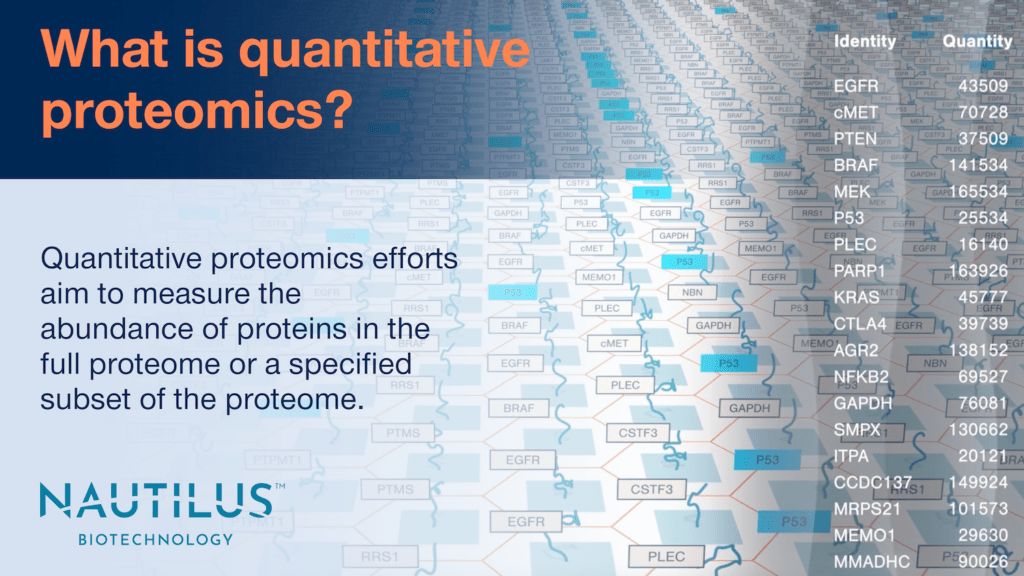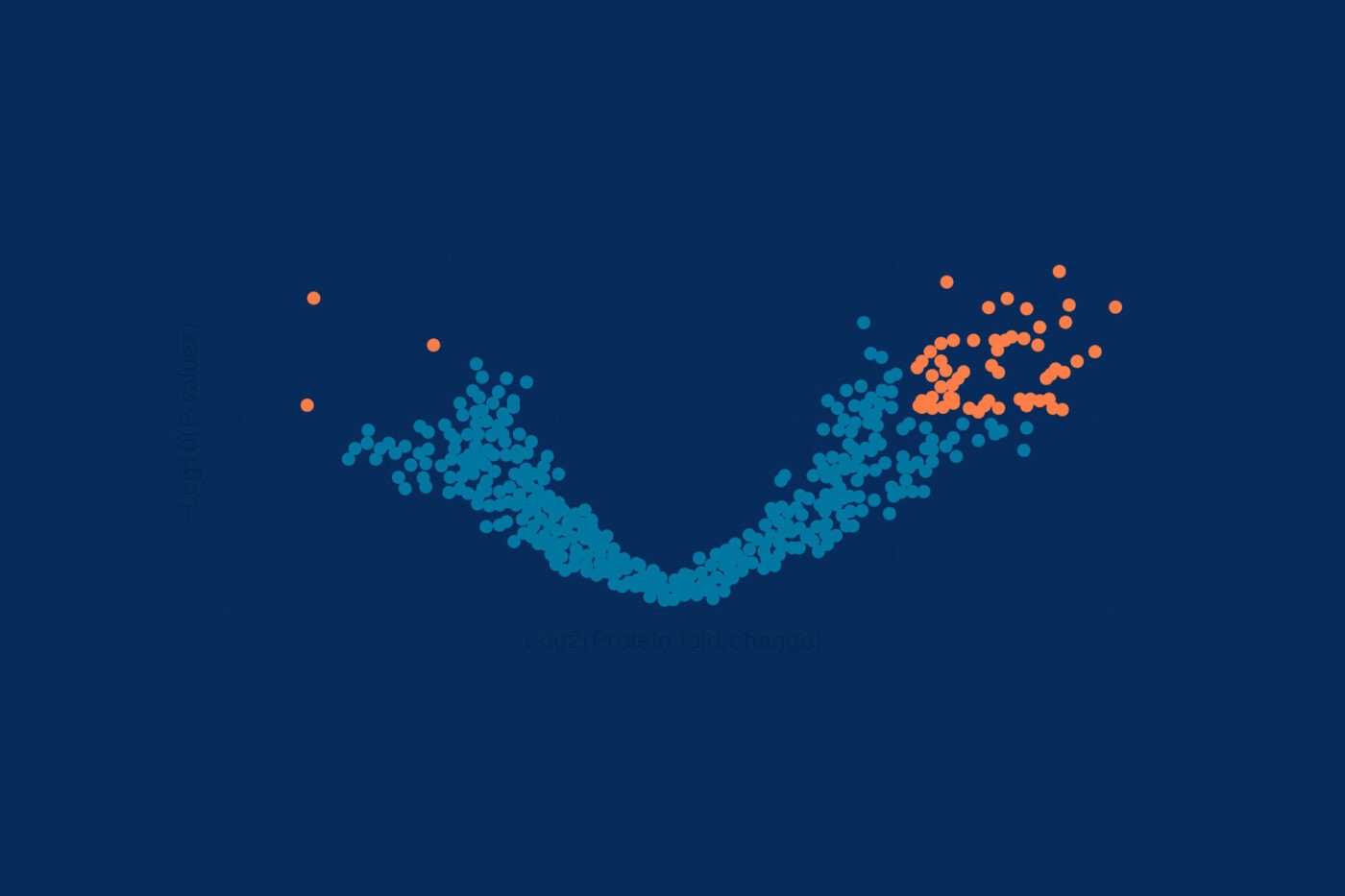
Quantitative proteomics efforts aim to measure the abundance of proteins in the full proteome or a specified subset of the proteome. These protein quantification techniques can reveal unique information about proteins in particular cells, tissues, or samples.
Why is quantitative proteomics important?
As the name suggests, the goal of quantitative proteomics is to measure the number and diversity of proteins in a sample or samples. While qualitative proteomics can show researchers what proteins are simply present in a biological sample, quantitative proteomics reveals how protein abundance differs between samples and thereby provides an indication of the diverse levels of protein activity between samples. With the appropriate precision and reproducibility, quantitative proteomics provides higher-quality and much more actionable data than qualitative proteomics. Proteome profiles generated through quantitative proteomics enable researchers to understand what differentiates their samples at the molecular level.
Quantitative proteomics is also key to functional proteomics efforts. Proteins whose abundances consistently change together, i.e. are consistently correlated, may be involved in the same function. Abundance measurements can thereby help researchers assign functions to proteins with unknown roles. If a quantitative proteomics technique is sensitive enough, it may even provide a measure of protein stoichiometries required for various functions.
For example, if a set of proteins forms a signaling complex on the surface of neurons, researchers might get an indication of the ratio of proteins in the functional complex by quantifying their abundance in neurons with active signaling. They could then use quantitative proteomics to compare the ratios of these proteins in different kinds of neurons to determine if the pathway has altered activity. These protein quantification efforts might even show that pathway protein levels are greatly altered in the diseased brain. Such results could support the hypothesis that the disease is caused by disruptions to this theoretical signaling complex.
General types of protein quantitation
Protein quantitation can be broken down into two main types:
- Relative quantitation – In this type of protein quantitation, researchers determine protein fold changes between samples, but do not measure how much protein is in a given sample without reference to another sample or standard.
- Absolute quantitation – In this type of protein quantitation, researchers determine the amount of protein in a sample without reference to other samples. This provides an absolute measure of protein abundance.
Relative quantitation is generally easier to achieve than absolute quantitation and often more than sufficient for the research goals at hand.
Beyond these broad types of protein quantitation, various methods also have different levels of precision. That is, they will have various amounts of uncertainty surrounding the abundance values they produce whether absolute or quantitative.
Technologies designed to provide digital measurements of single protein molecules (like the NautilusTM Proteome Analysis Platform) can be incredibly precise because they are designed to enable a researcher to count individual protein molecules rather than extrapolate abundance measurements from bulk signals.
Quantitative mass spectrometry in proteomics
The truth is that quantitative proteomics is challenging with current technologies. Many quantitative proteomics techniques involve some form of mass spectrometry. To retain proteome coverage and avoid complex and expensive mass spectrometry workflows, researchers often leverage relative protein quantitation between samples as opposed to absolute quantitation. This kind of proteomic analysis generally involves differentially labeling proteins from different samples, either with amino acid isotopes or specially designed chemical groups. The labeled proteins are then mixed and the ratios of the mass spectra from the various labels are measured to determine protein fold changes between samples.
Absolute quantitation, on the other hand, generally requires researchers to label their proteins, then spike similar samples with known amounts of labeled proteins or peptides to generate a calibration curve. Later this calibration curve is used to extrapolate protein levels in the sample by comparing mass spectra from the sample to the calibration curve. This approach is, by nature, very targeted. Researchers must make special preparations of specific proteins or peptides of interest to make the calibration curves. Even then, they may not be able to quantify their proteins of interest over a wide dynamic range.
Label-free quantitative proteomics
In label-free quantitative proteomics (reviewed here), researchers forgo the use of expensive labels and complex labeling workflows to conduct protein quantification. This kind of quantitative proteomics measures either:
- The intensity of mass spectrometry signals for a particular peptide across multiple samples run independently.
- Or the number of peptides identified for a particular protein across multiple samples run independently (so-called “spectral counting”).
These techniques are challenging because they require researchers to align runs and have some means of normalizing the signal intensity between runs of the mass spectrometer. Label-free protein quantitation is subject to subtle differences that arise between runs.
These techniques can be used for relative protein quantification, but additional normalization techniques based on peptide ionization propensity must be used to generate estimates of absolute protein quantity.
Protein quantitation on affinity-based platforms
A variety of proteomics technologies leverage affinity reagents to specifically bind to proteins of interest and generate a signal. These technologies can identify thousands of proteins and more signal is indicative of more protein. Generally, such technologies are used to provide measurements of relative protein abundance between samples after various normalization techniques, but they can be calibrated to standard curves for absolute quantification.
The future of quantitative proteomics is digital and single-molecule
To avoid the messy and complex use of labels and calibration curves, the ideal quantitative proteomics technology would enable researchers to digitally count proteins at the single-molecule level. If you can identify each single protein molecule in a sample, all you need to do is count the number of times a specific protein is identified to quantify it. This should give you the most accurate and precise measures of protein abundance and enable you to precisely compare protein quantities across samples.
Leveraging our novel, single-molecule protein quantification methodology called PrISM, the Nautilus Proteome Analysis Platform is designed to enable proteome-scale digital protein quantification. We hope researchers can routinely use our platform to accurately quantify proteins across a wide variety of sample types for much deeper insights into biology than are practically possible now.
Check out this animation to learn about protein quantification on the Nautilus Platform.
MORE ARTICLES


